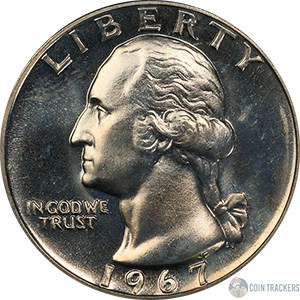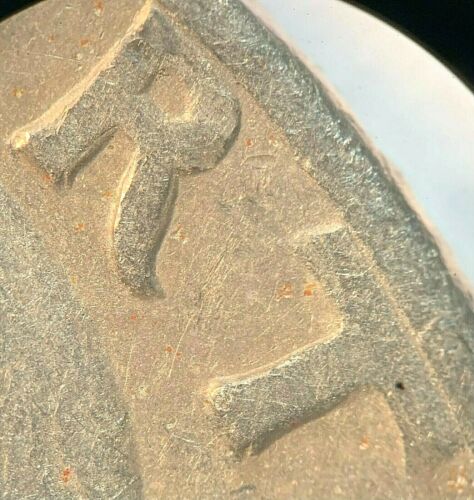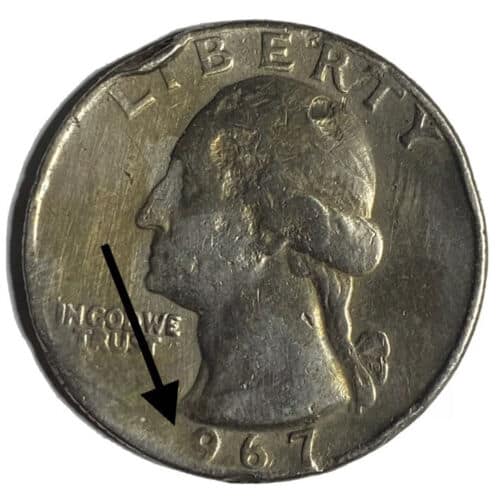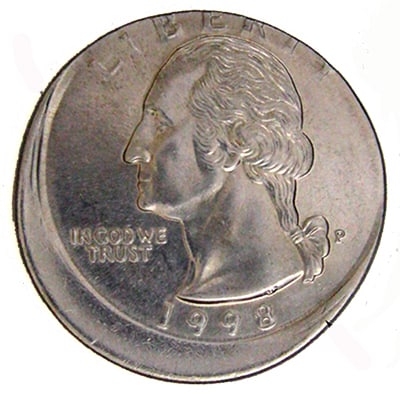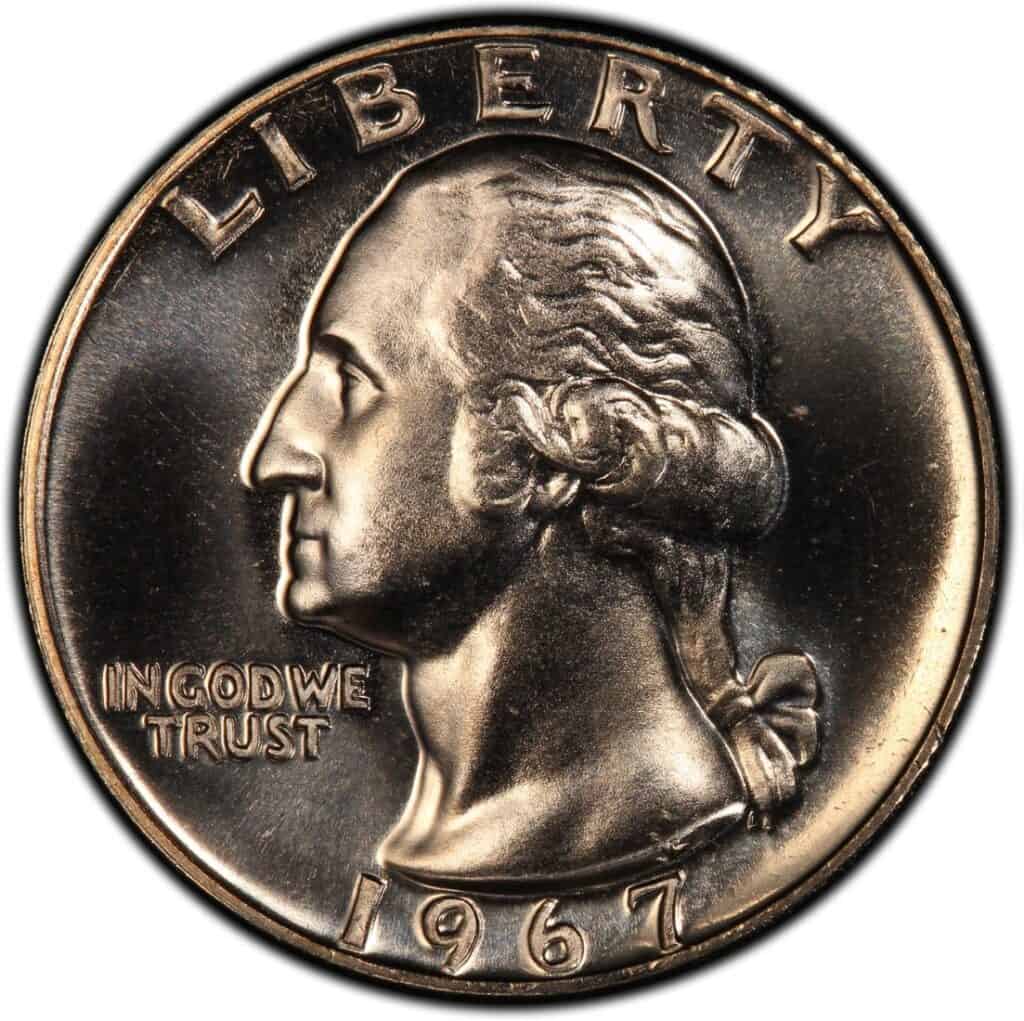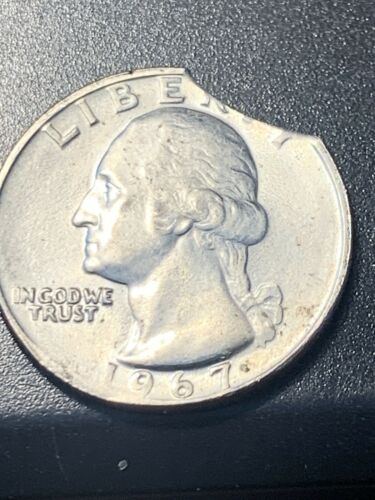Many factors contribute to a coin’s value, including rarity, historical significance, and brevity of circulation. Few coins excel in all three areas, but the 1967 quarter does just that. Given its unique composition due to economic and world history events of its time, the 1967 quarter’s value represents a moment in mint history of profound significance, increasing the value of uncirculated 1967 quarters to all-star collector status.
Year: 1967
Face Value: $0.25
Composition: 91.67% copper, 8.33% nickel
Total Weight: 5.67 grams
Diameter: 24.26 mm
Thickness: 1.75 mm
Edge: Notched
Minted in: Philadelphia and Denver
Quantity Minted: 1,524,031,848

photo source: cointrackers.com
Are 1967 Quarters Valuable?
The Coinage Act of 1965 was written to deter the collection of coins from 1965 to 1967 while the United States government attempted to meet a growing need for coinage. Because the price of silver was beginning to inflate beyond the face value of coins, and because a coin shortage was underway, collectors and regular citizens alike began to hoard coins for their silver value.
But the coinage act meant that silver was no longer used to produce these coins, lowering their value to the face value of the currency itself. In addition, mint marks were removed through 1967, making the 1967 quarter the last produced without a mint mark.
Thanks to these unique circumstances, a series of quarters were produced in the years between 1965 and 1967 that represent a significant moment in mint history.
Most uncirculated 1967 quarters with no errors are worth between $1 and $3 in a collection, making them worth about 6 times more than their face value, while circulated 1967 quarters have a value between $.25 and $1.
But if you can find a proof or mint condition 1967 quarter with certain errors, it can add a whopping $5,000.00 to the value of your coin collection.
Why Are There No Mint Marks In 1967 Quarters?
Mint marks indicate the location a coin was produced. Each mint has its own mark (D for Denver, C for Charlotte, etc.), and the mark can have an impact on the value and collectability of a coin. For the United States government, a mint mark is a quality control measure, tracing errors and flaws in production.
But to collectors, this mark indicates a story, history, and moment in US history that can grossly increase the value of a coin in a collection.
Because the US was experiencing a coin shortage, the government attempted to curb collecting and coin hoarding by removing the mint mark between 1965 and 1967 until mints could meet coin demand.
Without this mark, there’s no indication of where a coin was produced, hopefully minimizing the number of unique qualities that can contribute to collector interest.
Before 1965, the mint mark on a US quarter could be found on the reverse of the coin. But after this 2-year gap in mint marking, mints moved their marks to the front of the coin.
This shift in mint mark location is significant, and paired with a gap in mint marking in general the government inadvertently created a greater demand in collecting by crafting a brief series of coins with a special unique quality.
Is A 1967 Quarter Real Silver?
In 1965, inflation had driven the price of silver to exceed the face value of the US quarter dollar. In response to this, the government pivoted to a nickel and copper clad composition. Thus, by 1967 quarters were no longer made of silver.
Why Were Quarters Ever Made of Silver?
Coins, in US currency’s beginnings, were tied directly to the value of the metal that represented them. They were made of pure silver or copper, and denominated by weight rather than currency markings.
But as currency gained traction as a streamlined, vital component of society, its value became tied to the national and world economy rather than precious metals.
Denominated markings were added to coins, and as the value of silver rose nickel was added to the composition of these coins to mediate cost of production.
Eventually, the government deemed it disadvantageous to include silver in the composition of quarters at all. They’re now produced, instead, using a pure copper core with nickel and copper clad.
Are There Any Errors In The 1967 Quarter?
As with most collectable coins, 1967 quarters have a list of known errors that add rarity, value, and significance to a collection.
1967 Doubled Die Quarter
Face Value: $.25
Composition: Copper, nickel copper clad
Weight: 5.67 grams

photo source: www.ebay.com
When a quarter is doubled died, an additional image is transferred from a previous stamping. Spotting this in a 1967 quarter typically requires magnifying equipment and a trained eye. The 1967 doubled die quarters are typically affected in the imprinted words.
1967 Rim Error Quarter
Face Value: $.25
Composition: Copper, nickel copper clad
Weight: 5-5.67 grams

photo source: www.ebay.com
A rim error occurs when a quarter faces forced impact, damaging the raised rim. If this happens in mint, the value is higher. There is no added value if this happens in circulation.
1967 Off Center Error Quarter
Face Value: $.25
Composition: Copper, nickel copper clad
Weight: 5.5-5.67 grams

photo source: www.error-ref.com
This error is exactly as its name implies: the stamp was applied off center. Because these are so rare they are pretty valuable.
1967 Rim Oddity Quarter
Face Value: $.25
Composition: Copper, nickel copper clad
Weight: 5.1-5.67 grams

photo source: atticcapital.com
A rim oddity describes a misshapen rim that occurs in mint production, rather than by blunt force damage at the mint or in circulation. These errors can significantly increase the value of the 1967 quarter, depending on the coin’s condition.
1967 Clipped Planchet Quarter
Face Value: $.25
Composition: Copper, nickel copper clad
Weight: 4.5-5.67 grams

photo source: www.ebay.com
A clipped planchet is an error in stamping that occurs when the plate is slightly misplaced, resulting in a curved portion missing from the quarter entirely. This is a rare error, and a quarter with this oddity in mint condition can fetch a small fortune.
What Is The Value Of 1967 Quarters?
Since changing the composition of the quarter in 1965, its current melt value is a mere $0.0501707, far less than the face value of the coin. But given great condition and certain errors, quarters can fetch far above both the $.25 face value of the coin and the melt value.
| Coin | Grade | Value |
| 1967 Doubled Die Quarter | VG-8 | $.50 |
| MS-65 | $100 | |
| 1967 Rim Error Quarter | VG-8 | $.25 |
| MS-65 | $30 | |
| 1967 Off Center Quarter | VG-8 | $5 |
| MS-65 | $100 | |
| 1967 Rim Oddity Quarter | VG-8 | $.25 |
| MS-65 | $1,000 | |
| 1967 Clipped Planchet Quarter | VG-8 | $.25 |
| MS-65 | $3,000 |
How Does The Grading System Work?
The Sheldon Scale is used by numismatists to provide a numerical value to coins. The Sheldon Scale goes from poor (P-1) to perfect mint state (P-1) (MS-70). Coins were originally evaluated using words to reflect their condition (Good, Fair, Excellent, Etc.). Unfortunately, coin collectors and dealers had different ideas about what each of these terms represent.
Professional numismatists joined together in the 1970s and established CoinGrading standards. These numismatists now assign grades at key places on the seventy-point scale, using the most regularly utilized numeric points in conjunction with the original adjective grade. The following are the most common coin grades:
-
-
- (P-1) Poor – Indistinguishable and probably damaged; if used, must have a date and mintmark; otherwise, rather battered.
- (FR-2) Fair – Nearly smooth, but without the damage that a coin graded Poor often possesses. The coin must have enough detail to be identified.
- (G-4) Fair – Inscriptions have merged into the rims in some areas, and important elements have been mostly erased.
- (VG-8) Very Good- A little weathered, but all of the primary design elements are visible, albeit faintly. There is little if any, central detail left.
- (F-12) Good – The item is very worn, yet the wear is even, and the overall design details stand out clearly. Rims are almost completely isolated from the field.
- (VF-20) Very Fine – Moderately weathered, with some finer features still visible. The motto or all letters of LIBERTY are readable. Both sides of the coin have entire rims that are separated from the field.
- (EF-40) Extremely Fine – Gently used; all gadgets are visible, and the most important ones are bold. The finer details are bold and clear, however, light wear may be seen.
- (AU-50) Uncirculated – Slight evidence of wear on the coin’s design’s high points; may have contact marks; eye appeal should be adequate.
- (AU-58) Uncirculated Choice – Slight traces of wear, no severe contact marks, almost full mint shine, and great eye appeal.
- (MS-60) Mint State Basal – Strictly uncirculated; no indication of wear on the coin’s highest points, but an unsightly coin with reduced luster, visible contact marks, hairlines, and other flaws.
- (MS-63) Mint State Acceptable – Uncirculated, but with contact scratches and nicks, little reduced shine, but otherwise appealing appearance. The strike is weak to average.
- (MS-65) Mint State Choice – Uncirculated with great mint shine, very little contact blemishes, and exceptional eye appeal. The strike is unusually severe.
- (MS-68) Mint State Premium Quality – Uncirculated with superb luster, no obvious contact marks to the naked eye, and exceptional eye appeal. The strike is quick and appealing.
- (MS-69) Almost Perfect Mint State – Uncirculated with perfect brilliance, a sharp and appealing strike, and extremely good eye appeal. A near-perfect coin with minor imperfections in the planchet, strike, and contact markings (seen only under 8x magnification).
- (MS-70) Mint State Perfect – Under 8x magnification, there are no tiny imperfections discernible; the strike is crisp, and the coin is perfectly centered on a beautiful planchet. Rarely seen on a coin, this coin is bright and whole, with original luster and exceptional eye appeal.
-
Where To Buy Or Sell 1967 Quarters?
Like almost all other silver coins, you’re not likely to find one of these in your pocket change because most collectors have already bought them for their precious metal value. So, most people who buy and sell 1967 quarters do so through specialised dealers, antique shops and online markets.
The 1967 Quarters in grades up to AUG50 can be bought for $125 on Ebay and Etsy.
1967 Quarter FAQ
What makes a 1967 quarter rare? Both errors and high quality increase the rarity of a 1967 quarter.
What are the most valuable 1967 quarters?
- MS-68 1967 Quarter: Only one 1967 quarter has received this grade, and none have fetched a grade of MS-70. But in 2020, this quarter sold for about $5,000.
- There are a handful of MS-67 quarters, each valued around $500.
- The Special Mint Cameo 1967 quarter is worth about $5,000.
Where to buy and sell a 1967 quarter? These can be found in circulation if you ask a bank teller for a customer-rolled box of quarters, but you’ll have to hunt. To buy graded, evaluated 1967 quarters check sites like Ebay.com for certified collectables. Auctions may also pop up near you from time to time, which you can locate by joining collectors’ guilds and checking auction sites.
What is the value of a 1967 Canadian quarter? The 1967 Canadian quarter is worth between $.25 Canadian and $500, depending on quality and errors present.
How many quarters were minted in 1967? 1,524,031,848
How much is a 1967 mint set worth? A 1967 mint set generally sells for around $50, but can fetch upwards of $10,000 with rare errors and high quality.

